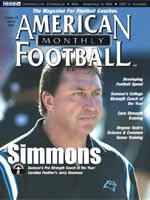AMERICAN FOOTBALL MONTHLY THE #1 RESOURCE FOR FOOTBALL COACHES
Article CategoriesAFM Magazine
|
Pride in the Work PlaceLSU\'s Tommy Moffitt is the 2003 Samson College Strength & Conditioning Coach of the Yearby: David Purdum © More from this issue Tommy Moffitt demands and gets results. He’s just not always there to see them. Moffitt, AFM’s Samson Strength & Conditioning Coach of the Year, helped tighten up Tennessee as the Vol’s head associate strength and conditioning coach from 1994-97. In 1998, after Moffitt had accepted a position under Butch Davis at Miami, Tennessee upset Florida State in the Fiesta Bowl to capture the first BCS National Championship. Bad timing. Moffitt spent the next two years in Miami and helped the ‘Canes return to national prominence, before accepting the strength and conditioning coordinator position at LSU in 2000. In 2001, Miami beat Nebraska in the Orange Bowl and captured the national title, the school’s first in 10 years. Again, bad timing. But through experience, Moffitt’s timing has imp....The full article can only be seen by subscribers. Subscribe today!
|
|
|||||||
| HOME |
MAGAZINE |
SUBSCRIBE | ONLINE COLUMNISTS | COACHING VIDEOS |
Copyright 2025, AmericanFootballMonthly.com
All Rights Reserved





